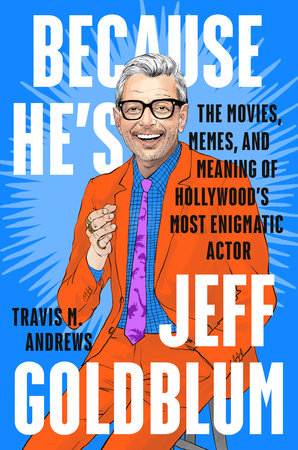1.
Goldblum, Erected
Look, this is going to be a strange book. I'm sorry about that, I truly am, but there's no way around it. This isn't by design. The nature of the subject simply demands such treatment. Jeff Goldblum is a strange character with a strange story. Consider his 2009 death scare. Great place to begin, right? On the day Michael Jackson actually died, Goldblum fictitiously died. In an early Internet death hoax, reports of his falling off a cliff in New Zealand while filming an episode of Law & Order: Criminal Intent-you know, the show that's very much set in New York City, a place that looks exactly like New Zealand-began circulating online. He, obviously, did not fall off any cliffs, much less die, and Dick Wolf did not film his show in the same place as The Lord of the Rings. The actor didn't die, but for a while, many people thought he had died. (As the Guardian insightfully noted at the time, the gag "underlined his cult status: Goldblum was obscure enough to make it believable, and loved enough to make it upsetting.") He thought the rumor was "nasty" and has discussed "the mill of information-spreading that is not based on facts," saying, "That can be alarming and poisonous, and we should be very vigilant about rejecting it." But at the same time, he appeared on The Colbert Report to goof on it. That contradiction might not make sense (yet) but it fully explains Goldblum's approach to acting and to life, which can be (and often is) paraphrased as "live truthfully under fictional circumstances." He's unknowable, strange, and enigmatic, but in the very best way. One reporter said trying to isolate the capital-T Truth about him is "like trying to nail jelly to a greased piglet." That pretty much sums it up. Only a fool would attempt such a thing, particularly as an entire book. Luckily for you, my publisher, my agent, and (maybe?) myself, I've always been a fool. A quick survey of my family and friends will prove that. So my deepest apologies in advance, but this is going to be a weird ride. Case in point: the first chapter, which just so happens to be the chapter you are currently reading, begins with a 330-pound, 25-foot-tall, bare-chested Goldblum.
Take a gander:
The sun dipped slowly into the river Thames in the late afternoon of July 19, 2018. It was one of those perfect midsummer days, in which the sky was bluer than Frank Sinatra's eyes and the air was as still as a wax museum, while the sun languidly set over the water in a glorious display. This serenity is usually what draws all the late-afternoon joggers, dog-walkers, and picnicking new lovers to Potters Fields Park. But that night, the sunset might as well have been an afternoon screening of the movie Cats, because no one bothered to so much as offer it a cursory glance.
Instead, everyone's eyes were locked on an art installation recently erected in the grass, where it would remain towering over visitors for a week. The thing was massive, the size of Paul Bunyan, if Bunyan were (a) a real person and (b) slightly better dressed. More than one onlooker's sexuality was called into question, as were a few relationship choices. It's frankly incredible the joggers didn't run into each other. How many glasses of wine overflowed as an idle hand kept pouring while its connected pair of distracted eyes was locked on the chiseled map that made up the statue's abs?
Some young folks only slightly recognized the figure, but anyone who came of age in the 1990s knew immediately what delicious flesh they beheld: that of Dr. Ian Malcolm, i.e., Jeff Goldblum's sexy, dino-doubting mathematician from Jurassic Park. Here, as in the movie, his shirt hung open as he reclined on one cocked arm like a swimsuit model from the 1960s, staring out into the great unknown, even though his leg had just been mauled by a Tyrannosaurus rex.
So, naturally, everyone did what everyone does in the face of spectacle these days: they whipped out their phones and took awkwardly framed photos of that statue while thinking of clever quips to write on Instagram and trying to find the proper hashtag.
There was a certain irony to the statue. After all, in Jurassic Park, his character famously decries the idea of bringing back dinosaurs, believing that something could go terribly wrong. And here he lay, two decades later, looking perfectly preserved, the size of a dino himself.
"This monstrously large Jeff Goldblum is how I like to imagine the man himself in his true form," Helen McClory, who wrote a slim volume of flash fiction about our man called The Goldblum Variations, told CNN at the time. "Or how he would have appeared in the age of megafauna."
"Life doesn't have nearly enough large statues of men as sex symbols, so it redressed the balance a little," she later told me. "I never got to see it in person, which is sad. I hope it's touring about and I might get to, one of these days."
Unfortunately, the statue was coming down on July 26, and Goldblum was busy recording a jazz album in the United States (much more on this later, I promise). He didn't have time to saunter on down to the park to look at a gargantuan representation of his younger self, so he didn't get to see it in person.
Months later, while promoting said jazz album, Goldblum appeared on The Graham Norton Show alongside Jamie Lee Curtis.
"I didn't know it was going up. I found out the day it went up," Goldblum told Norton, still visibly excited by the absurdity-which has been something of his lifeblood over the decades.
Norton responded that there was a surprise in store for the actor and walked across the stage to what appeared to be an end table draped with a dark cloth, which the host quickly whipped off. Goldblum's jaw fell open when he saw what sat beneath: his own noggin, only much, much, much larger, now removed from its body, which had recently sprawled out before London's Tower Bridge.
Norton picked up the statue's head, and he began wobbling under its weight like a cartoon character. Goldblum jumped out of his seat and was quickly replaced with the head.
"Look at that thing!" he exclaimed. "Look at that thing. Oh, my golly."
"You can post it on Facebook," Curtis gleefully interjected.
"True or false: a pun is the lowest form of humor," Goldblum ribbed back without taking a pause.
The entire time, a papier-m‰chŽ head, larger than an average eight-year-old, sat on the couch and stared blankly into the audience.
Perhaps the strangest part of the statue episode was that Goldblum wasn't the first actor to be praised in such fashion, but it was the first time that anyone really noticed or cared. In 2013, a twelve-foot-tall statue of Colin Firth appeared in the middle of the Serpentine, a lake in Hyde Park, London. It showed Firth as Mr. Darcy from Pride and Prejudice, complete with a soaking-wet white shirt clinging to his well-defined arms and chest. Yet it didn't create much buzz. The Hollywood Reporter offered one of the more energetic quotes about the statue: "It makes swimming a bit more interesting, and I think the swans like it."
Goldblum as a subject, though, has the inherent power to make oddities go viral. It seems there's just something about Jeff Goldblum.
Take the Croydon Salvos store in Australia.
While the whole Goldblum statue saga played out, a much smaller-and, one might say, more personal-Goldblum shrine was being erected in the Australian charity store. It's part of the shop's running gag in which they fill every picture frame on display with photos of a different celebrity each month. Normally, this occurs under the radar, amusing only local fans. But this time felt different.
The store, in which a variety of Goldblums stared out of every picture frame, became known to the world through a visitor who documented the whole shebang on Twitter in September 2018. Quickly, the story went viral, being picked up by outlets as varied as Time, the Nerdist, and Travel and Leisure. And of course, BuzzFeed. Things then took an even stranger turn when other people started chiming in that, yeah, this isn't actually all that uncommon. Johnny Haeusler in Berlin, Germany, quickly shared a photo of his office's bathroom (the men's, presumably). The green tile of one wall was only visible around the edges of dozens upon dozens of photos of Goldblum at various stages in his life.
Now, if you were to tell this pair of stories to someone who had the misfortune of never having heard the name Jeff Goldblum-perhaps this person had lived under a literal rock, meaning this person was recently dead and somehow resurrected into the world having missed Goldblum's decades-long career-then they would probably gawk at you a moment, ask the obvious question ("The world still has sculptors with this sort of time on their hands?"), and then inquire as to the identity of the art's subject.
"This Goldblum fella," this recently undead person might say, "I guess he's probably a huge movie star or something?"
"Well, he was," you'd reply. "Like, twenty years ago. I mean, he still has some big roles every once a while, but he's not really a leading man any longer. In fact, now that I think about it, he never really was a leading man per se, but he was a really likable character actor. I can name at least four movies in which he's appeared, though that doesn't sound like that many, now that I'm saying all of this out loud. By the way, how on earth did you manage to come back from the dead? That seems way more important than why this actor is so beloved, right?"
"Oh, well, then maybe he's embarked on a stunning second career of some sort. Is that it?"
You would probably begin puzzling over this question, finally answering that though the actor still appears from time to time in big movies, by the end of the 2010s, his big passion was . . . playing jazz piano.
"So he must have been the most famous jazz musician at the time, right?"
You would then be placed in the bewildering position of having to reveal that until recently only his most die-hard fans knew he even played jazz piano in the first place and that casual culture consumers were surprised by the whole endeavor. That it was one of those tidbits of trivia that get lost in a sea of information, something that most people might have once known as a solid cocktail party anecdote but had faded from memory. And that until he recently released his first album, most people had no idea he was a talented musician who had been playing for decades.
In fact, you would be forced to conclude, there is absolutely no discernible reason why Goldblum should be as wildly popular as he is.
And yet, he is.
In some ways, before writing this book, I was an outlier. In fairness, I had a rough start with Goldblum. I was eight or nine years old the first time I saw him on-screen, and he scared the ever-living shit out of me. My babysitter chose to leave me unsupervised and sit in the other room, flirting with her boyfriend over the phone, and The Fly came on television. I couldnÕt look away. For weeks, I was plagued with horrible visions of a half-Goldblum, half-housefly creature leaning his head into my room right as I was falling asleep. Of course, these days, some people might welcome such a midnight visitor. Rest assured a young me was not among them.
Given the tremendous range of Goldblum's filmography, I suspect many of you have similarly distinct memories of first seeing the actor. Maybe he represented an exciting life in the city if you first caught him as People magazine journalist Michael Gold in The Big Chill. Maybe seeing him in Jurassic Park as that chiseled brainiac led to an early sexual awakening. Or maybe, like me, he just scared the crap out of you when his DNA merged with that of a common housefly. One way or another, Goldblum was a formative part of childhood for more than one generation of Americans.
But while I had long been aware that seemingly everyone loved Goldblum, I was never quite sure why they still did. It seemed as if his time had passed. Sure, after the whole The Fly incident, I began watching his movies. I respect him as an actor and even adore some of his more bizarre performances, particularly his character in Thor: Ragnarok, to which he brought some seriously surreal, off-kilter energy as the fabulously dressed Grandmaster (who, in one deleted scene, appears to make out with alien tentacles). And Wes Anderson movies always appeal to me about 10 percent more if Goldblum appears in them.
But the fact that he is a living meme? That, I never understood.
The day the statue appeared, I was sitting in the newsroom of the Washington Post, where I work as a reporter for the Style section. I like to believe I excel at my job, but I couldn't understand why the statue existed, much less why it was being so celebrated. After all, that statue of Firth had appeared in the past to such little fanfare. (Sorry, Firth!)
I asked several of my Style colleagues the same question, only to be met with the same answer.
ME: I just don't get it. Why are people so nuts for Jeff Goldblum?
MORE INFORMED PERSON: Because he's Jeff Goldblum!
Understanding this was the correct answer, but still unsatisfied with it and vaguely bored, I decided it'd be fun to figure out why Goldblum is so universally famous, so beloved, and so devoid of controversy, scandal, and haters. It seemed like a better usage of my time than watching the middle portion of Goodfellas on TBS for like the fiftieth time.
The story of his fame has three potential beginnings. One is a familiar tale, beginning in West Homestead, Pennsylvania, that includes a dream of acting and a move to New York City. The second is unique, involving a number of dinosaurs, houseflies, big screens, and sex appeal. The third would seem downright bizarre in any other decade, for it involves the actor's watching you poop.
Strangely, it's this third story that cemented him as a modern-day hero.
The late-stage careers of aging actors in the new millennium generally follow a a few well-worn paths. Some retire, others burn out, and others still have their careers sunk by scandal. But the most common one involves starsÕ aging like fine wines. As they earn stately wrinkles and regal gray coiffures, many former heartthrobs take on Serious Oscar-bait roles or choose to play against type in popcorn flicks-while mostly remaining out of the spotlight, particularly the sort of spotlight that comes with the viral social media stunts that have become the bread and butter of modern fame. (Think Adam Sandler crashing a wedding photo shoot. Or Tom Hanks crashing a wedding photo shoot. Or Will and Jada Pinkett Smith crashing a wedding photo shoot. Or . . . well, you probably get the point.)
Copyright © 2020 by Travis M. Andrews. All rights reserved. No part of this excerpt may be reproduced or reprinted without permission in writing from the publisher.







